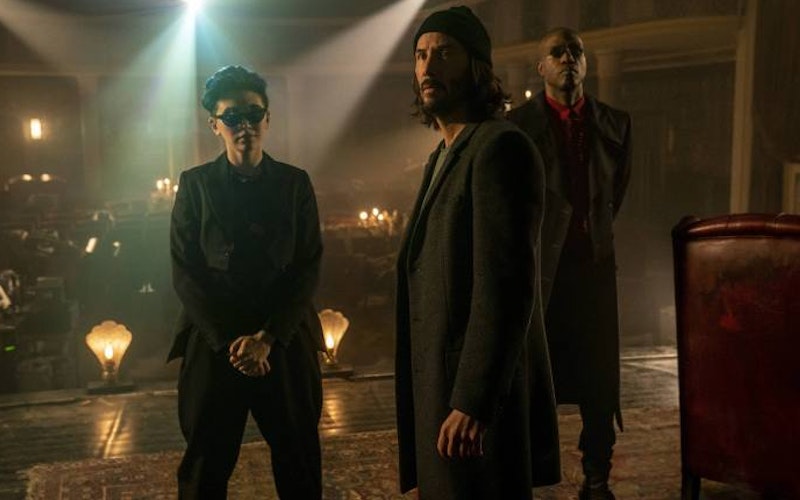
Movies
The Matrix Resurrections’ Prophetic Strawberries
What happens after the messiah saves the world? Strawberries, apparently.
Coming over 20 years after the original The Matrix, The Matrix Resurrections returns to a world at war, one where sentient machines house human bodies as living batteries, trapping each person’s consciousness in a computer simulation of the world as we know it. The original trilogy introduced us to a messiah named Neo (Keanu Reeves), prophesied to be the One who would end the war by dying in appropriately messianic fashion. The new film asks what happened next, after Neo’s self-sacrifice in 2003’s The Matrix Revolutions. In doing so, it offers a provocative picture of what a world created by a dying messiah looks like.
Much has been made about director Lana Wachowski's return to the trilogy, how her new film comments on corporate demands that franchises continue (with or without their creators) and how it further considers the nature of human identity (at the time of the original 1999 film, both Lana and her sister/co-director Lilly identified as men). But I can't get past one deliciously meta detail: the strawberries. (Spoilers ahead.)
In the new film, Reeves once again plays Thomas Anderson (the “simulated” version of his character in The Matrix). This time, within the Matrix, Anderson is a legendary video-game designer whose Matrix trilogy (evocative of the first three films) was a massive success a generation ago. A new crew of free humans who have escaped the machines’ battery pods—including Jessica Henwick’s Bugs and Yahya Abul-Mahteen II’s Morpheus—once again free Neo from his Thomas Anderson simulation. They bring him to the last human city (IO this time, not Zion). There, he encounters a society with a marked difference from the one he died to save: here, humans and friendly machines (or, rather, “sentients,” as they prefer to be called) live together. Their crowning, collaborative achievement so far? Strawberries.
That's not as inconsequential as it sounds. Humans are the last organic life on Earth. During the war, humanity “scorched the sky” to cut off the sunlight that the machines used for power (which is why they turned to humans as batteries). All of this means there are no strawberries in Zion. But IO has strawberries. How?
The Matrix Resurrections offers a provocative picture of what a world created by a dying messiah looks like.
We learn that the sentients brought computer code for strawberries out of the Matrix, then worked with human scientists to convert that code into genetic code, building new strawberries. It's a clever bit of science fiction that embodies the hope Neo represented in the original Matrix: that the One can end the war between humans and machines, not by destroying the machines but by making peace.
The messianic subtext nearly surfaces here. Colossians insists that Jesus "made peace through his blood, shed on the cross." Concerning the first-century church's sharpest ethnic division—that between Jew and Gentile—Ephesians states, "[Jesus] himself is our peace, who has made the two groups one and has destroyed the barrier, the dividing wall of hostility." IO's strawberries are a tangible expression of this new world coming into being. Through the peace Neo created, sentients and humans together are healing the world, restoring what the war destroyed.
What would Mouse think about IO’s strawberries? In the original film, Mouse (Matt Doran) is a member of the human crew that rescues Neo. As they share a meal of processed slop with the newly awakened Neo, Mouse points out that no one knows what anything really tasted like before the war. All of them emerged from the Matrix, where their “senses” are really computer codes. “Take chicken, for example,” Mouse observes. “Maybe [the machines] couldn't figure out what to make chicken taste like, which is why chicken tastes like everything. ”
Resurrections begs the question, is this a real strawberry? But asking, "Is this a real X?" is to miss the point. It's the fallacy of nostalgia, of assuming that the age of something, or its genetic heritage, is somehow its essential, defining feature. Resurrections warns that nostalgia can be an anesthetic. The first film is populated with disaffected Gen Xers convinced the world is wrong, anxious to take the red pill and wake up. Resurrections finds Neo at middle-age, having sold out to the corner office and corporate lattes. Older Neo has too much invested in the way things are. He fights being awakened.
When we meet The Analyst (Neil Patrick Harris), the new, malevolent program who runs the Matrix, he confirms that this is part of the machines’ strategy. The Analyst has exchanged facts for feelings because “feelings are so much easier to control than facts.” He insists that people don't want to be awakened. We want to live in a reality that conforms to our familiar desires.
In Revelation, Jesus invites us to wake up into a new reality. That vision ends with the Kingdom of God descending among humans: Zion on earth. At the heart of the city is a river and the tree of life, echoes of Eden. But this is not a return to the past. It is a new thing, one that honors the pain of the journey from Eden to Zion. Whether or not the new city is just like the old garden is the wrong question (and, of course, it's not). The new city is a new thing, one made possible by all that has come before—every joy and triumph but also every hurt and pain, resurrected and redeemed by a messiah who was dead and is alive.
In Zion, the fruit of the tree of life is for “the healing of the nations.” Is this the same fruit we were given in Genesis 2, the fruit that grants eternal life? Do the strawberries taste like strawberries? That's the wrong question. The strawberries are good signs of a world that's healing, a healing made possible by the work of the chosen one.
Topics: Movies